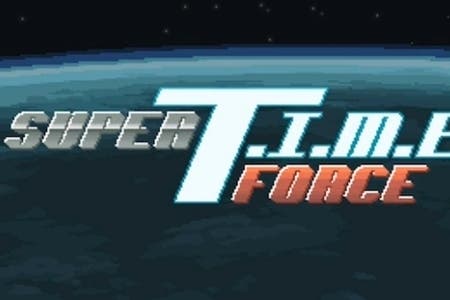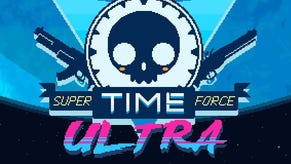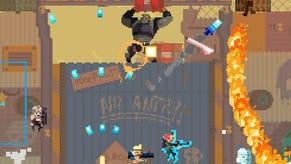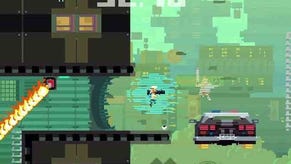Super Time Force is super hard, super interesting and more than a little like Super Contra
Capy's hardcore run-and-gunner takes time travel to absurd new extremes.
Don't take Super Time Force seriously.
That advice comes straight from Capybara Games head Nathan Vella, although it's easy enough to tell just from a cursory look at the developer's unique, absurdist take on side-scrolling run-and-gun shooters. The game's trailer - a crazy Saturday morning cartoon mash-up that channels Ren and Stimpy's John Kricfalusi with meme-ish, Adventure Time-esque humour - is solid enough evidence of the game's tongue-in-cheek tone. Nor can it hurt that one of the playable characters happens to be a '90s stereotype dinosaur that rides a skateboard. (His name? Zackasaurus.)
"We really want to make it clear that the game does not in any way take itself seriously," Vella says. "It's a real reflection of people that work at Capy - we're not big fans of being super serious, [at least] in certain situations."
Maybe Super Time Force's biggest paradox, then, is how its hardcore gameplay clashes with its jokey demeanor; after the team receives a goofy mission briefing from their boss, you're left to your own devices in a decidedly hostile environment (like Contra, one-hit kills are in effect.)
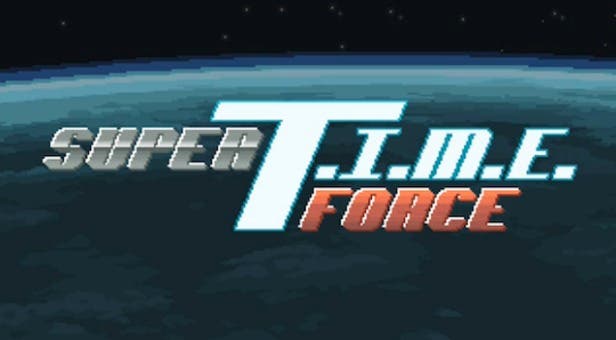
Herein lies the beauty of Capy's twisted design. The more you die in Super Time Force, the more the screen is cluttered with your previous lives, playing out until the point of their death. This often becomes a crucial part of Super Time Force's strategy. Rather than simply showing you the ghost of your past movements, your past lives take effect in the environment and enemies around in you; every time you die, another soldier is added to your ever increasing army.
"You're basically playing co-op with the dead you," Vella says.
While it's often a good idea to leverage the power of your past lives to take out swathes of enemies (every time you die, the game rewinds back to the beginning of the level), your finite supply of lives demands you step in and actively prevent their deaths from time to time as well.
Let's say you take a machine gunner responsible for ending past life #3's existence before they can jump to their doom in a hail of gunfire. With that past self still alive, you can now collect it to gain an extra life, simultaneously creating a one-use checkpoint - any midlevel progress you can gain is actually recorded by these past lives, so once you respawn where you first collected them, they're gone for good.
30 lives (likely a knowing wink to the Konami code) seems like an ample starting supply considering the game's difficulty, but the average player performance would make for a pretty unstable wave pattern if plotted out of graph paper.
At the same time, you can't just skate through a level on the merits of your past lives, either. Taking a page from Sine Mora, killing enemies and rescuing past lives adds time to the game's clock - gameplay dictates you can only exist in a time paradox for 30 seconds, adding a bit of pressure to an already hectic scenario.
The process of actually mapping out the game's design, which started out as a side project after a Toronto game jam last year, has been interesting, Vella says.
"We're actually trying to do real time-bendy mind-f*** stuff while also making it really basic Contra-like fun," he says.
The layers get deeper in your character selection. All play styles have more or less been accounted for: the core roster includes a well-balanced gunner with a spread shot charge, a sniper that can shoot through walls (watch that kickback!), a longer range rocket launcher type and a slower shield blocker that can deflect enemy bullets, with other unlockable characters waiting to be rescued for different play styles. Where things get really wild is in mixing and matching types, so after letting a few spreaders and rocketeers loose, you can barrel through with the shield blocker, for instance.
Regardless of how you choose to play, Super Time Force has been built for replay, leaderboards and speedruns. More than a few times during my hands-on time, I noticed level specifics that were either easier or considerably harder depending on who I was playing as at the time.

Making my way through a prehistoric jungle, I noticed it was much easier to fell a heavily armored ankylosaurus while dodging a couple of faster moving dinos and air projectiles using the rocket launcher character, although the directional concentration of his attacks were less effective on the multi-point T-Rex boss at the end of the level (yes, apparently dinosaurs are a big thing in Super Time Force). Vella calls this "playing the Mega Man game."
It's a game that's likely to resonate with the Meat Boy crowd, too, since a skilled player will be able to finish one of its bite-sized levels in less than a minute. The first stage of the PAX Prime demo, a brighter, less scary and no easier cityscape sort of in the vein of Contra 3's opening stage, only takes up about three screen's worth of scrolling, to give you some idea.
I didn't necessarily perform to that gold standard during my play session, though dying repeatedly gave me a good idea of the sheer insanity you encounter when the screen is littered with the possibly-doomed shadows of your former self; Vella told me the game breaks when your on-screen legion numbers in the hundreds, though the working figure for the game's XBLA release is about 60.
In any case, more elite players will have their work cut out for them setting records with the tougher to use characters even after initial mastery of the game. The hardcore style is just how Capy likes it, Vella says, and if you've got the option to throw in a T-Rex president, so much the better.
"I like a challenge and I like to make games that are not afraid to be a challenge," he says.
I can hardly wait to check the achievements.
